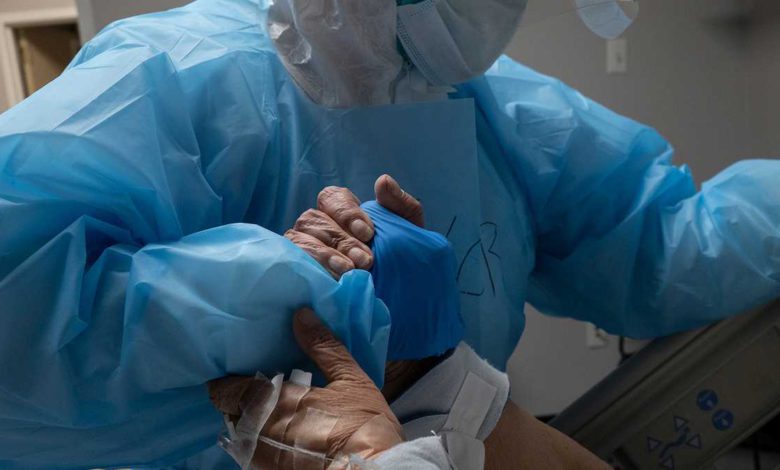

More than 90,000 Americans could die of COVID-19 in the next three weeks, according to new predictions from the U.S. Centers for Disease Control and Prevention. This is occurring as the United States has just surpassed 392,000 deaths, with the country shattering the record of over 4,000 deaths per day for two days last week.The numbers are sobering. Public health experts have sounded the alarm for months that even with the great promise of vaccines on the horizon, there are dark days ahead, with the worst of the pandemic potentially yet to come.What do these projections mean? We talked to CNN Medical Analyst Dr. Leana Wen, an emergency physician and visiting professor at George Washington University Milken Institute School of Public Health, to learn how people can make sense of the numbers and what can be done to change the trajectory of the pandemic.CNN: The CDC is predicting over 90,000 deaths over three weeks. Can those numbers be right?Wen: Unfortunately, yes. We are averaging between 3,000 and 4,000 deaths every single day from COVID-19. To get to that awful number of 90,000 deaths in three weeks, that's about 4,300 deaths per day. With rising infections and hospitalizations, it's almost certain that we will also see a steady uptick in the daily death rate.This is so tragic, and I hope that we do not become numb to these numbers. Each person is someone's grandparent, parent, spouse, child or friend.CNN: Is there anything we can do about this terrible trend?Wen: There isn't very much we can do about the trajectory of deaths that we will see in the next three weeks. That's because of the lag time: It typically takes a week or so between the time that someone is exposed and when they show symptoms, then another week or so to become ill enough to be hospitalized, then days to weeks before someone were to succumb to the disease.The people we could see dying in the next two or three weeks are those who have already been exposed to coronavirus, possibly during the December holiday season. The best that can be done is for these individuals to seek prompt medical care and to receive the best care possible to treat their illness, but it's too late to prevent them from getting infected.That's not the case for all the people who haven't been infected yet. There is a big difference between modeling for a weather forecast and modeling for an infectious disease. You may be able to predict the path of a hurricane and then get out of that path, but you can't change where the hurricane goes. That's different with a pandemic. The future is not preordained. Our individual and collective actions now are what determine how much the virus spreads.We've been talking about basic public health measures for months now, and they are still our best guard against this very contagious respiratory illness. Keeping physical distance — because this virus requires close contact. Being outdoors is better than indoors — because outdoor air disperses virus particles. Wearing a mask — that can prevent transmitting and acquiring coronavirus. Avoiding crowded gatherings — and knowing that more than half of transmission (according to the CDC) is by people who don't have symptoms and who may be infected but not know it. Washing our hands frequently and well.These measures are additive. The more you do, the more consistently, the better you're protected. Our individual actions protect us and those around us. They also protect the community, by lowering the spread of coronavirus and helping to reduce the strain on our overwhelmed hospitals and public health systems. Collectively, our actions help to change the trajectory of the disease and are key to stopping this escalating surge.CNN: Why do you think the numbers keep climbing? Is it that people are just tired of following these precautions?Wen: That's certainly a part of it. Pandemic fatigue is very real. We need to acknowledge it. Yes, there are some people who don't believe coronavirus is real and may be flouting masking and social distancing guidelines. However, I think a lot of people have tried very hard to follow precautions but are finding this increasingly difficult not to see loved ones. They may be letting down their guard, and there can be tragic consequences.Another reason is that people may be misunderstanding what the arrival of the vaccines mean. There is such limited supply, and distribution of vaccines has been much slower than we would have liked. Many people will not have access to the vaccines for months. Even those who have had the vaccine may still be able to spread the virus to others.Don't get me wrong — the vaccines will be a game changer when enough people can get vaccinated. It's incredible that we have safe and highly efficacious vaccines. But they are not what's going to get us out of this very dangerous surge. What will get us out are these public health measures.I wish there were an easier way out. I think everyone would want that, and I know that everyone is tired and wish that this pandemic could end. But we need to continue to be vigilant and keep up our guard.CNN: President-elect Joe Biden said he's going to ask for 100 days of mask wearing. Will that make a difference?Wen: Yes. An influential model by the University of Washington shows that mask wearing can save 30,000 lives between now and March. That's really remarkable. President-elect Biden has talked about masks as a patriotic duty, a way for us to show respect for one another. We should be wearing masks any time we are outside and cannot keep 6 feet apart from others, and any time we are inside with those not in our immediate family.Not having gatherings, indoors, with anyone we don't live with will also make a huge difference. In many parts of the country, what's driving the latest surge are these indoor gatherings — think dinner parties and game nights. It's in these intimate settings that people are letting down their guard and getting infected.I understand why people want to get together with their extended family and friends. The weather is cold, and it's hard to see one another outdoors. However, our loved ones are just as likely to be asymptomatic carriers of COVID-19 as strangers. We need to be extremely careful and only have outdoor or virtual visits with those not in our immediate household.CNN: With many new coronavirus infections, does that impact how people should think about grocery shopping or other basic activities?Wen: When there are high rates of coronavirus in the community, it makes all our activities higher risk. The activities that were low risk before are higher risk. That's because there are just so many people around us who are carrying coronavirus, and the chance of encountering someone — and being infected by them — just becomes higher.I'm seeing more patients who have no idea where they contracted the coronavirus. There is a familiar story: They have been so careful to quarantine and not expose themselves to risk. Maybe all they're doing is going to work in environments that require masks and distancing, or maybe only exposures they have are through grocery shopping and running errands.There is just so much coronavirus around us that the same activities that were pretty safe a few months ago are just riskier now. That means we need to be even more vigilant. If you were going grocery shopping once a week, consider reducing it to once every two weeks. If you are particularly vulnerable to severe disease, consider having your groceries delivered. Be even more attentive if you have to take the subway or bus to get to work. Of course, wear a mask at all times (at least a three-ply surgical mask). Again, make sure that you do not get together indoor with people, even your close friends.CNN: Is there hope coming in the spring? Will warmer weather help?Wen: It's hard to know for sure. Coronavirus spreads more in cold weather. Warmer weather also means that people are going to be able to see one another outdoors more, and that can alleviate some of the loneliness people are feeling while also being safe. As we get into spring, more people are going to be able to be vaccinated, too, and that will also be protective.That means we have to hang in there just a little bit longer. There is hope on the horizon, but we do have some difficult weeks and months ahead. We can get through it, with optimism and caution.
More than 90,000 Americans could die of COVID-19 in the next three weeks, according to new predictions from the U.S. Centers for Disease Control and Prevention. This is occurring as the United States has just surpassed 392,000 deaths, with the country shattering the record of over 4,000 deaths per day for two days last week.
The numbers are sobering. Public health experts have sounded the alarm for months that even with the great promise of vaccines on the horizon, there are dark days ahead, with the worst of the pandemic potentially yet to come.
What do these projections mean? We talked to CNN Medical Analyst Dr. Leana Wen, an emergency physician and visiting professor at George Washington University Milken Institute School of Public Health, to learn how people can make sense of the numbers and what can be done to change the trajectory of the pandemic.
CNN: The CDC is predicting over 90,000 deaths over three weeks. Can those numbers be right?
Wen: Unfortunately, yes. We are averaging between 3,000 and 4,000 deaths every single day from COVID-19. To get to that awful number of 90,000 deaths in three weeks, that's about 4,300 deaths per day. With rising infections and hospitalizations, it's almost certain that we will also see a steady uptick in the daily death rate.
This is so tragic, and I hope that we do not become numb to these numbers. Each person is someone's grandparent, parent, spouse, child or friend.
CNN: Is there anything we can do about this terrible trend?
Wen: There isn't very much we can do about the trajectory of deaths that we will see in the next three weeks. That's because of the lag time: It typically takes a week or so between the time that someone is exposed and when they show symptoms, then another week or so to become ill enough to be hospitalized, then days to weeks before someone were to succumb to the disease.
The people we could see dying in the next two or three weeks are those who have already been exposed to coronavirus, possibly during the December holiday season. The best that can be done is for these individuals to seek prompt medical care and to receive the best care possible to treat their illness, but it's too late to prevent them from getting infected.
That's not the case for all the people who haven't been infected yet. There is a big difference between modeling for a weather forecast and modeling for an infectious disease. You may be able to predict the path of a hurricane and then get out of that path, but you can't change where the hurricane goes. That's different with a pandemic. The future is not preordained. Our individual and collective actions now are what determine how much the virus spreads.
We've been talking about basic public health measures for months now, and they are still our best guard against this very contagious respiratory illness. Keeping physical distance — because this virus requires close contact. Being outdoors is better than indoors — because outdoor air disperses virus particles. Wearing a mask — that can prevent transmitting and acquiring coronavirus. Avoiding crowded gatherings — and knowing that more than half of transmission (according to the CDC) is by people who don't have symptoms and who may be infected but not know it. Washing our hands frequently and well.
These measures are additive. The more you do, the more consistently, the better you're protected. Our individual actions protect us and those around us. They also protect the community, by lowering the spread of coronavirus and helping to reduce the strain on our overwhelmed hospitals and public health systems. Collectively, our actions help to change the trajectory of the disease and are key to stopping this escalating surge.
CNN: Why do you think the numbers keep climbing? Is it that people are just tired of following these precautions?
Wen: That's certainly a part of it. Pandemic fatigue is very real. We need to acknowledge it. Yes, there are some people who don't believe coronavirus is real and may be flouting masking and social distancing guidelines. However, I think a lot of people have tried very hard to follow precautions but are finding this increasingly difficult not to see loved ones. They may be letting down their guard, and there can be tragic consequences.
Another reason is that people may be misunderstanding what the arrival of the vaccines mean. There is such limited supply, and distribution of vaccines has been much slower than we would have liked. Many people will not have access to the vaccines for months. Even those who have had the vaccine may still be able to spread the virus to others.
Don't get me wrong — the vaccines will be a game changer when enough people can get vaccinated. It's incredible that we have safe and highly efficacious vaccines. But they are not what's going to get us out of this very dangerous surge. What will get us out are these public health measures.
I wish there were an easier way out. I think everyone would want that, and I know that everyone is tired and wish that this pandemic could end. But we need to continue to be vigilant and keep up our guard.
CNN: President-elect Joe Biden said he's going to ask for 100 days of mask wearing. Will that make a difference?
Wen: Yes. An influential model by the University of Washington shows that mask wearing can save 30,000 lives between now and March. That's really remarkable. President-elect Biden has talked about masks as a patriotic duty, a way for us to show respect for one another. We should be wearing masks any time we are outside and cannot keep 6 feet apart from others, and any time we are inside with those not in our immediate family.
Not having gatherings, indoors, with anyone we don't live with will also make a huge difference. In many parts of the country, what's driving the latest surge are these indoor gatherings — think dinner parties and game nights. It's in these intimate settings that people are letting down their guard and getting infected.
I understand why people want to get together with their extended family and friends. The weather is cold, and it's hard to see one another outdoors. However, our loved ones are just as likely to be asymptomatic carriers of COVID-19 as strangers. We need to be extremely careful and only have outdoor or virtual visits with those not in our immediate household.
CNN: With many new coronavirus infections, does that impact how people should think about grocery shopping or other basic activities?
Wen: When there are high rates of coronavirus in the community, it makes all our activities higher risk. The activities that were low risk before are higher risk. That's because there are just so many people around us who are carrying coronavirus, and the chance of encountering someone — and being infected by them — just becomes higher.
I'm seeing more patients who have no idea where they contracted the coronavirus. There is a familiar story: They have been so careful to quarantine and not expose themselves to risk. Maybe all they're doing is going to work in environments that require masks and distancing, or maybe only exposures they have are through grocery shopping and running errands.
There is just so much coronavirus around us that the same activities that were pretty safe a few months ago are just riskier now. That means we need to be even more vigilant. If you were going grocery shopping once a week, consider reducing it to once every two weeks. If you are particularly vulnerable to severe disease, consider having your groceries delivered. Be even more attentive if you have to take the subway or bus to get to work. Of course, wear a mask at all times (at least a three-ply surgical mask). Again, make sure that you do not get together indoor with people, even your close friends.
CNN: Is there hope coming in the spring? Will warmer weather help?
Wen: It's hard to know for sure. Coronavirus spreads more in cold weather. Warmer weather also means that people are going to be able to see one another outdoors more, and that can alleviate some of the loneliness people are feeling while also being safe. As we get into spring, more people are going to be able to be vaccinated, too, and that will also be protective.
That means we have to hang in there just a little bit longer. There is hope on the horizon, but we do have some difficult weeks and months ahead. We can get through it, with optimism and caution.
Source link







